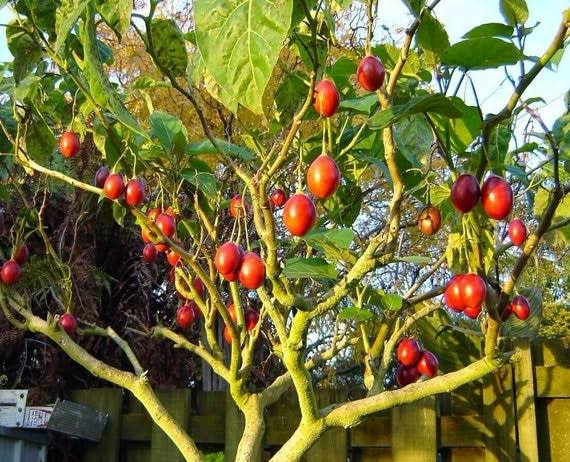Tamarillos, scientifically known as Solanum betaceum, are fascinating fruits that boast a vibrant history and a unique blend of flavors. These egg-shaped wonders are also commonly referred to as tree tomatoes, reflecting their appearance and the fact that they grow on trees.
Originating from South America, tamarillos have journeyed across continents, finding their way into various cuisines worldwide. With their smooth, thin skin that can range in color from red to orange to yellow, these fruits immediately catch the eye. When you cut one open, the inside reveals a juicy, seedy flesh that carries a distinctive tangy and slightly sweet taste.
Tamarillos are rich in essential nutrients, including vitamins A and C, which contribute to their reputation as a healthy addition to one’s diet. Their versatility in the kitchen is noteworthy – you can enjoy them fresh, sliced into salads, or incorporated into sauces, jams, and chutneys. The vibrant color and bold flavor of tamarillos add a unique touch to both sweet and savory dishes.
Beyond their culinary uses, tamarillos have cultural significance in many regions. Some communities regard the fruit as a symbol of good luck, while others incorporate it into traditional ceremonies and rituals. This reflects the deep connection between tamarillos and the diverse cultures that have embraced them over centuries.
The cultivation of tamarillos requires specific climatic conditions, typically thriving in subtropical or mild temperate climates. Their trees are hardy, providing shade and producing a bounty of fruits for those who tend to them with care. Despite their hardiness, tamarillo trees demand attention and expertise to ensure a fruitful harvest.
In addition to their delightful taste, tamarillos also contribute to the biodiversity of ecosystems where they grow. Their trees attract various pollinators and play a role in supporting local fauna. As guardians of genetic diversity, tamarillos carry within them the potential to adapt to changing environmental conditions, making them valuable in the realm of agriculture and sustainability.
From their South American origins to global kitchens, tamarillos continue to captivate with their vibrant hues, unique flavors, and contributions to both health and biodiversity. Whether enjoyed fresh or incorporated into diverse recipes, these tree tomatoes have etched their place in the tapestry of global gastronomy and cultural heritage.
Read Also: Goats Farming Complete Practical Guide
The History of Tamarillos

The history of tamarillos traces back to their roots in South America, where these distinctive fruits found their origin. Scientifically known as Solanum betaceum, tamarillos have a long and intriguing story that unfolds across centuries.
Originally cultivated in the Andes region, tamarillos were a staple in the diet of indigenous communities. The vibrant fruit became a symbol of sustenance and a source of essential nutrients for these populations. The indigenous people not only consumed tamarillos for their flavor but also recognized their medicinal properties.
As European explorers and colonizers set foot in South America, they encountered the tamarillo and were intrigued by its unique characteristics. The fruit’s journey to other continents began as it caught the attention of botanists and horticulturists who recognized its potential beyond its native lands. Tamarillos, or tree tomatoes as they came to be known, were introduced to various regions, adapting to new climates and culinary traditions.
Over time, tamarillos became integrated into the cuisines of different cultures around the world. Their vibrant colors and distinct flavor profile contributed to the diversification of culinary practices, with chefs and home cooks alike experimenting with these exotic fruits in an array of recipes.
In some cultures, tamarillos took on symbolic meanings and became associated with traditions and rituals. Whether considered a harbinger of good luck or incorporated into religious ceremonies, tamarillos became woven into the fabric of diverse societies.
The cultivation of tamarillos expanded, and today they are grown in subtropical and mild temperate climates globally. As these fruits traveled across borders, they not only became a source of nutrition but also played a role in supporting local economies and agriculture.
The history of tamarillos is a tale of discovery, adaptation, and integration. From their humble beginnings in the Andes to becoming a global culinary sensation, these fruits have transcended geographical boundaries and cultural differences, leaving a flavorful mark on the world’s history of agriculture and gastronomy.
The Nutritional Values of Tamarillos

Tamarillos, scientifically known as Solanum betaceum, offer a range of nutritional benefits, making them a valuable addition to a balanced diet. These fruits are not only flavorful but also pack a punch in terms of essential nutrients.
Tamarillos are a good source of vitamins, particularly vitamin A and vitamin C. Vitamin A is crucial for maintaining healthy skin, vision, and immune function, while vitamin C acts as an antioxidant, supporting the immune system and promoting skin health. The combination of these vitamins in tamarillos contributes to overall well-being.
In addition to vitamins, tamarillos provide dietary fiber, aiding in digestion and promoting a healthy gut. Fiber is essential for maintaining regular bowel movements and can contribute to a feeling of fullness, which may assist in weight management.
Tamarillos also contain minerals such as potassium and copper. Potassium is important for maintaining proper heart and muscle function, while copper plays a role in the formation of red blood cells and supports the immune system.
While tamarillos offer a range of nutrients, it’s important to note that they are relatively low in calories and fat. This makes them a nutritious option for those looking to maintain a healthy weight or reduce their calorie intake.
Tamarillos are a nutritional powerhouse, providing a mix of vitamins, minerals, and dietary fiber. Whether enjoyed fresh or incorporated into various dishes, these fruits contribute to a well-rounded and health-conscious diet.
Read Also: Introduction to Ruminant Animals Production
Health Benefits of Tamarillos

Tamarillos, scientifically known as Solanum betaceum, offer several health benefits owing to their rich nutritional profile. Incorporating these fruits into your diet may contribute to overall well-being in various ways:
1. Rich in Antioxidants: Tamarillos are loaded with antioxidants, particularly vitamin C. Antioxidants help combat oxidative stress in the body, reducing the risk of chronic diseases and supporting a healthy immune system.
2. Promotes Skin Health: The presence of vitamin A in tamarillos is beneficial for skin health. Vitamin A plays a crucial role in maintaining skin integrity, promoting cell turnover, and supporting a radiant complexion.
3. Boosts Immune Function: The combination of vitamins A and C in tamarillos strengthens the immune system. These vitamins contribute to the body’s defense against infections and illnesses, keeping you better protected.
4. Supports Heart Health: Tamarillos contain potassium, a mineral that plays a role in maintaining a healthy heart. Adequate potassium intake helps regulate blood pressure and reduces the risk of cardiovascular issues.
5. Aids Digestion: Tamarillos are a good source of dietary fiber, promoting digestive health. Fiber adds bulk to the stool, preventing constipation and supporting a healthy digestive system.
6. Weight Management: The fiber content in tamarillos contributes to a feeling of fullness, potentially assisting in weight management by reducing overall calorie intake.
7. Regulates Blood Sugar Levels: The fiber and nutrient content in tamarillos may contribute to better blood sugar control. Including these fruits in a balanced diet can be beneficial for individuals managing diabetes.
8. Contributes to Bone Health: Tamarillos contain essential minerals like copper, which is involved in bone formation. Adequate copper intake supports overall bone health and may reduce the risk of bone-related issues.
9. Anti-Inflammatory Properties: Some compounds found in tamarillos may possess anti-inflammatory properties, potentially reducing inflammation in the body and providing relief from inflammatory conditions.
10. Hydration and Electrolyte Balance: The high water content in tamarillos contributes to hydration, and the presence of potassium helps maintain electrolyte balance in the body.
Incorporating tamarillos into a balanced and varied diet can be a delicious way to reap these health benefits and contribute to overall nutritional well-being. As with any food, moderation is key to achieving a diverse and wholesome diet.
How to Grow Tamarillos (Growing Guide)
Growing tamarillos, scientifically known as Solanum betaceum, can be a rewarding experience. Here’s a basic guide to help you cultivate these vibrant fruits:
1. Climate and Soil: Tamarillos thrive in subtropical or mild temperate climates with well-draining soil. Plant them in a location that receives full sun for optimal growth.
2. Planting:
Choose the Right Variety: Select a tamarillo variety suitable for your climate.
Seed or Seedling: You can grow tamarillos from seeds, but it’s often quicker to start with nursery-bought seedlings.
Spacing: Plant seedlings about 10 to 15 feet apart to allow ample space for growth.
Soil Preparation: Ensure the soil is well-draining and slightly acidic. Add organic matter like compost for nutrient-rich soil.
3. Watering: Tamarillos require regular watering, especially during dry periods. Keep the soil consistently moist but avoid waterlogging, as they are susceptible to root rot.
4. Mulching: Apply a layer of organic mulch around the base of the plant to retain moisture, suppress weeds, and regulate soil temperature.
5. Fertilizing: Use a balanced fertilizer with equal proportions of nitrogen, phosphorus, and potassium. Apply during the growing season, typically spring and summer.
6. Pruning: Prune tamarillo trees to encourage a strong structure and increase air circulation. Remove dead or crowded branches to promote healthy growth.
7. Support: Young tamarillo plants may need staking or support until they establish a sturdy root system.
8. Pests and Diseases: Keep an eye out for common pests like aphids or whiteflies. Insecticidal soap can be used for control. Fungal diseases can be prevented by maintaining good air circulation and avoiding overwatering.
9. Harvesting: Tamarillos are usually ready for harvest when the fruits have reached their full color and are slightly soft to the touch. Gently twist or cut the fruits from the tree. They will continue to ripen after harvesting.
10. Storage: Store harvested tamarillos at room temperature until fully ripe. Once ripe, refrigerate for extended freshness.
11. Additional Tips: Tamarillos can be grown in containers, especially in cooler climates, allowing for mobility and protection during colder months. Regularly monitor the pH of the soil, aiming for a slightly acidic to neutral range.
Read Also: 5 Reasons to Prioritize Health and Fitness in Schools





